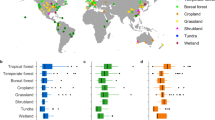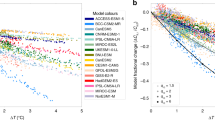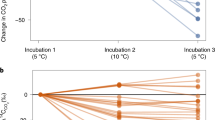Abstract
Soils contain more carbon than the atmosphere and vegetation combined. An increased flow of carbon from the atmosphere into soil pools could help mitigate anthropogenic emissions of carbon dioxide and climate change. Yet we do not know how quickly soils might respond because the age distribution of soil carbon is uncertain. Here we used 789 radiocarbon (∆14C) profiles, along with other geospatial information, to create globally gridded datasets of mineral soil ∆14C and mean age. We found that soil depth is a primary driver of ∆14C, whereas climate (for example, mean annual temperature) is a major control on the spatial pattern of ∆14C in surface soil. Integrated to a depth of 1 m, global soil carbon has a mean age of 4,830 ± 1,730 yr, with older carbon in deeper layers and permafrost regions. In contrast, vertically resolved land models simulate ∆14C values that imply younger carbon ages and a more rapid carbon turnover. Our data-derived estimates of older mean soil carbon age suggest that soils will accumulate less carbon than predicted by current Earth system models over the twenty-first century. Reconciling these models with the global distribution of soil radiocarbon will require a better representation of the mechanisms that control carbon persistence in soils.
This is a preview of subscription content, access via your institution
Access options
Access Nature and 54 other Nature Portfolio journals
Get Nature+, our best-value online-access subscription
$29.99 / 30 days
cancel any time
Subscribe to this journal
Receive 12 print issues and online access
$259.00 per year
only $21.58 per issue
Buy this article
- Purchase on Springer Link
- Instant access to full article PDF
Prices may be subject to local taxes which are calculated during checkout



Similar content being viewed by others
Data availability
The gridded maps of soil ∆14C and MCA are archived at Zenodo (https://doi.org/10.5281/zenodo.3823612). Other data that support the findings of this study are publicly available. Soil ∆14C measurements are available at https://zenodo.org/record/2613911#.XsNtQi-z124. Global soil carbon and soil clay content in SoilGrids are available at https://landgis.opengeohub.org. Soil carbon content in HWSD is available at https://go.nature.com/2ASmPC3. Global soil order data are available at https://go.nature.com/3hgdsgb. The climate data used can be downloaded from https://crudata.uea.ac.uk/cru/data/hrg/. The land cover map can be obtained from the MODIS Land cover MCD12Q1 product (https://lpdaac.usgs.gov/products/mcd12q1v006/). The permafrost map was generated by the National Snow and Ice Data Center (https://go.nature.com/2AZbTTe).
Code availability
All code relating to this study is available from the corresponding author upon request.
References
Zhu, Z. et al. Greening of the Earth and its drivers. Nat. Clim. Change 6, 791–795 (2016).
Schimel, D., Stephens, B. B. & Fisher, J. B. Effect of increasing CO2 on the terrestrial carbon cycle. Proc. Natl Acad. Sci. USA 112, 436–441 (2015).
Minasny, B. et al. Soil carbon 4 per mille. Geoderma 292, 59–86 (2017).
Todd-Brown, K. E. O. et al. Changes in soil organic carbon storage predicted by Earth system models during the 21st century. Biogeosciences 11, 2341–2356 (2014).
Schlesinger, W. H. Evidence from chronosequence studies for a low carbon-storage potential of soils. Nature 348, 232–234 (1990).
van Groenigen, K. J. et al. Faster turnover of new soil carbon inputs under increased atmospheric CO2. Glob. Change Biol. 23, 4420–4429 (2017).
Richter, D. D., Markewitz, D., Trumbore, S. E. & Wells, C. G. Rapid accumulation and turnover of soil carbon in a re-establishing forest. Nature 400, 56–58 (1999).
Plaza, C. et al. Direct observation of permafrost degradation and rapid soil carbon loss in tundra. Nat. Geosci. 12, 627–631 (2019).
Sanderman, J., Hengl, T. & Fiske, G. J. Soil carbon debt of 12,000 years of human land use. Proc. Natl Acad. Sci. USA 114, 9575–9580 (2017).
Trumbore, S. Radiocarbon and soil carbon dynamics. Annu. Rev. Earth Planet. Sci. 37, 47–66 (2009).
Torn, M. S., Trumbore, S. E., Chadwick, O. A., Vitousek, P. M. & Hendricks, D. M. Mineral control of soil organic carbon storage and turnover. Nature 389, 170–173 (1997).
Lawrence, C. R. et al. An open-source database for the synthesis of soil radiocarbon data: International Soil Radiocarbon Database (ISRaD) version 1.0. Earth Syst. Sci. Data 12, 61–76 (2020).
He, Y. et al. Radiocarbon constraints imply reduced carbon uptake by soils during the 21st century. Science 353, 1419–1424 (2016).
Stuiver, M. & Polach, H. A. Discussion reporting of 14C data. Radiocarbon 19, 355–363 (1977).
Hemingway, J. D. et al. Mineral protection regulates long-term global preservation of natural organic carbon. Nature 570, 228–231 (2019).
Kramer, M. G. & Chadwick, O. A. Climate-driven thresholds in reactive mineral retention of soil carbon at the global scale. Nat. Clim. Change 8, 1104–1108 (2018).
Xu, X. et al. Soil properties control decomposition of soil organic carbon: results from data-assimilation analysis. Geoderma 262, 235–242 (2016).
Rasmussen, C. et al. Beyond clay: towards an improved set of variables for predicting soil organic matter content. Biogeochemistry 137, 297–306 (2018).
Lalonde, K., Mucci, A., Ouellet, A. & Gélinas, Y. Preservation of organic matter in sediments promoted by iron. Nature 483, 198–200 (2012).
Gentsch, N. et al. Temperature response of permafrost soil carbon is attenuated by mineral protection. Glob. Change Biol. 24, 3401–3415 (2018).
Carvalhais, N. et al. Global covariation of carbon turnover times with climate in terrestrial ecosystems. Nature 514, 213–217 (2014).
Fan, N. et al. Apparent ecosystem carbon turnover time: uncertainties and robust features. Earth Syst. Sci. Data Discuss. https://doi.org/10.5194/essd-2019-235 (2020).
Schuur, E. A. G. et al. Climate change and the permafrost carbon feedback. Nature 520, 171–179 (2015).
Reimer, P. J. et al. IntCal13 and Marine13 radiocarbon age calibration curves 0–50,000 years cal BP. Radiocarbon 55, 1869–1887 (2013).
Balesdent, J. et al. Atmosphere–soil carbon transfer as a function of soil depth. Nature 559, 599–602 (2018).
Lawrence, D. M. et al. The Community Land Model Version 5: description of new features, benchmarking, and impact of forcing uncertainty. J. Adv. Model. Earth Syst. 11, 4245–4287 (2019).
Zhu, Q. et al. Representing nitrogen, phosphorus, and carbon interactions in the E3SM Land Model: development and global benchmarking. J. Adv. Model. Earth Syst. 11, 2238–2258 (2019).
Chen, J. et al. Comparison with global soil radiocarbon observations indicates needed carbon cycle improvements in the E3SM Land Model. J. Geophys. Res. Biogeosci. 124, 1098–1114 (2019).
Koven, C. D. et al. The effect of vertically resolved soil biogeochemistry and alternate soil C and N models on C dynamics of CLM4. Biogeosciences 10, 7109–7131 (2013).
Koven, C. D., Hugelius, G., Lawrence, D. M. & Wieder, W. R. Higher climatological temperature sensitivity of soil carbon in cold than warm climates. Nat. Clim. Change 7, 817–822 (2017).
Sierra, C. A., Hoyt, A. M., He, Y. & Trumbore, S. E. Soil organic matter persistence as a stochastic process: age and transit time distributions of carbon in soils. Glob. Biogeochem. Cycles 32, 1574–1588 (2018).
Hobley, E., Baldock, J., Hua, Q. & Wilson, B. Land-use contrasts reveal instability of subsoil organic carbon. Glob. Change Biol. 23, 955–965 (2017).
Pellegrini, A. F. A. et al. Fire frequency drives decadal changes in soil carbon and nitrogen and ecosystem productivity. Nature 553, 194–198 (2018).
Davidson, E. A. & Janssens, I. A. Temperature sensitivity of soil carbon decomposition and feedbacks to climate change. Nature 440, 165–173 (2006).
Parton, W. J., Stewart, J. W. B. & Cole, C. V. Dynamics of C, N, P and S in grassland soils: a model. Biogeochemistry 5, 109–131 (1988).
Bond-Lamberty, B., Bailey, V. L., Chen, M., Gough, C. M. & Vargas, R. Globally rising soil heterotrophic respiration over recent decades. Nature 560, 80–83 (2018).
Harris, I., Jones, P. D., Osborn, T. J. & Lister, D. H. Updated high-resolution grids of monthly climatic observations—the CRU TS3.10 Dataset. Int. J. Climatol. 34, 623–642 (2014).
Hengl, T. et al. SoilGrids250m: global gridded soil information based on machine learning. PLoS ONE 12, e0169748 (2017).
Soil Survey Staff Soil Taxonomy: A Basic System of Soil Classification for Making and Interpreting Soil Surveys 2nd edn (USDA, 1999).
Levin, I. & Kromer, B. Twenty years of atmospheric 14CO2 observations at Schauinsland station, Germany. Radiocarbon 39, 205–218 (1997).
Levin, I., Kromer, B. & Hammer, S. Atmospheric Δ14CO2 trend in Western European background air from 2000 to 2012. Tellus B 65, 20092 (2013).
Hua, Q., Barbetti, M. & Rakowski, A. Z. Atmospheric radiocarbon for the period 1950–2010. Radiocarbon 55, 2059–2072 (2013).
Friedl, M. A. et al. MODIS Collection 5 global land cover: algorithm refinements and characterization of new datasets. Remote Sens. Environ. 114, 168–182 (2010).
Sierra, C. A. et al. Predicting decadal trends and transient responses of radiocarbon storage and fluxes in a temperate forest soil. Biogeosciences 9, 3013–3028 (2012).
Schrumpf, M. et al. Storage and stability of organic carbon in soils as related to depth, occlusion within aggregates, and attachment to minerals. Biogeosciences 10, 1675–1691 (2013).
Gaudinski, J. B., Trumbore, S. E., Davidson, E. A. & Zheng, S. H. Soil carbon cycling in a temperate forest: radiocarbon-based estimates of residence times, sequestration rates and partitioning of fluxes. Biogeochemistry 51, 33–69 (2000).
Thompson, M. V. & Randerson, J. T. Impulse response functions of terrestrial carbon cycle models: methods and application. Glob. Change Biol. 5, 371–394 (1999).
Sierra, C. A., Müller, M., Metzler, H., Manzoni, S. & Trumbore, S. E. The muddle of ages, turnover, transit, and residence times in the carbon cycle. Glob. Change Biol. 23, 1763–1773 (2017).
Harmonized World Soil Database Version 1.2 (FAO, 2012).
Brown, J., Ferrians O. Jr, Heginbottom, J. & Melnikov, E. Circum-Arctic Map of Permafrost and Ground-Ice Conditions (US Geological Survey, 1997).
Collier, N. et al. The International Land Model Benchmarking (ILAMB) system: design, theory, and implementation. J. Adv. Model. Earth Syst. 10, 2731–2754 (2018).
Bonan, G. B. et al. Model structure and climate data uncertainty in historical simulations of the terrestrial carbon cycle (1850–2014). Glob. Biogeochem. Cycles 33, 1310–1326 (2019).
Lawrence, D. M. et al. The land use model intercomparison project (LUMIP) contribution to CMIP6: rationale and experimental design. Geosci. Model Dev. 9, 2973–2998 (2016).
Brunke, M. A. et al. Implementing and evaluating variable soil thickness in the Community Land Model, Version 4.5 (CLM4.5). J. Clim. 29, 3441–3461 (2016).
Acknowledgements
This work was supported by the European Research Council (Horizon 2020 Research and Innovation Programme, grant agreement 695101, to S.T. and J.T.R.), by the US DOE Office of Science Biological and Environmental Research RUBISCO Science Focus Area (to J.T.R. and Q.Z.) and award DE-SC0014374 (to S.D.A. and J.T.R.) and by a NASA Earth and Space Science Fellowship (to P.A.L.).
Author information
Authors and Affiliations
Contributions
Z.S., Y.H., S.D.A., S.T. and J.T.R. designed the study; Z.S. and Y.H. analysed the data using machine learning and other approaches; P.A.L., W.R.W. and Q.Z. provided analysis of the land surface models; J.B.-M., A.M.H., P.A.L. and S.T. contributed to the development of the version of the ISRaD dataset used here; Z.S., S.D.A. and J.T.R. wrote the paper with substantial contributions from all of the authors.
Corresponding author
Ethics declarations
Competing interests
The authors declare no competing interests.
Additional information
Peer review information Primary Handling Editor: Rebecca Neely.
Publisher’s note Springer Nature remains neutral with regard to jurisdictional claims in published maps and institutional affiliations.
Supplementary information
Supplementary Information
Supplementary Figs. 1–17 and Tables 1–5.
Rights and permissions
About this article
Cite this article
Shi, Z., Allison, S.D., He, Y. et al. The age distribution of global soil carbon inferred from radiocarbon measurements. Nat. Geosci. 13, 555–559 (2020). https://doi.org/10.1038/s41561-020-0596-z
Received:
Accepted:
Published:
Issue Date:
DOI: https://doi.org/10.1038/s41561-020-0596-z
This article is cited by
-
Emergent temperature sensitivity of soil organic carbon driven by mineral associations
Nature Geoscience (2024)
-
Innovative approaches in soil carbon sequestration modelling for better prediction with limited data
Scientific Reports (2024)
-
Historical impacts of grazing on carbon stocks and climate mitigation opportunities
Nature Climate Change (2024)
-
Projected soil carbon loss with warming in constrained Earth system models
Nature Communications (2024)
-
Soil depth gradients of organic carbon-13 – A review on drivers and processes
Plant and Soil (2024)



